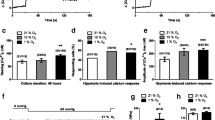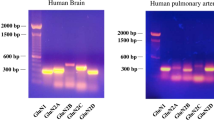Abstract
Electrical excitability, which plays an important role in excitation–contraction coupling in the pulmonary vasculature, is regulated by transmembrane ion flux in pulmonary artery smooth muscle cells (PASMC). This study aimed to characterize the electrophysiological properties and molecular identities of voltage-gated Na+ channels in cultured human PASMC. We recorded tetrodotoxin (TTX) sensitive and rapidly inactivating Na+ currents with properties similar to those described in cardiac myocytes. Using RT-PCR, we detected transcripts of seven Na+ channel α genes (SCN2A, 3A, 4A, 7A, 8A, 9A, and 11A), and two β subunit genes (SCN1B and 2B). Our results demonstrate that human PASMC express TTX-sensitive voltage-gated Na+ channels. Their physiological functions remain unresolved, although our data suggest that Na+ channel activity does not directly influence membrane potential, intracellular Ca2+ release, or proliferation in normal human PASMC. Whether their expression and/or activity are heightened in the pathological state is discussed.




Similar content being viewed by others
References
Aggarwal R, Shorofsky SR, Goldman L, Balke CW (1997) Tetrodotoxin-blockable calcium currents in rat ventricular myocytes: a third type of cardiac cell sodium current. J Physiol 505:353–369
Amédée T, Renaud JF, Jmari K, Lombet A, Mironneau J, Mironneau M (1986) The presence of Na+ channels in myometrial smooth muscle cells is revealed by specific neurotoxins. Biochem Biophys Res Commun 137:675–681
Arnon A, Hamlyn JM, Blaustein MP (2000) Na+ entry via store-operated channels modulates Ca2+ signaling in arterial myocytes. Am J Physiol Cell Physiol 278:C163–C173
Boccara G, Choby C, Frapier JM, Quignard JF, Nargeot J, Dayanithi G, Richard S (1999) Regulation of Ca2+ homeostasis by atypical Na+ currents in cultured human coronary myocytes. Circ Res 85:606–613
Choby C, Mangoni ME, Boccara G, Nargeot J, Richard S (2000) Evidence for tetrodotoxin-sensitive sodium currents in primary cultured myocytes from human, pig and rabbit arteries. Pflügers Arch 440:149–152
Cole WC, Chartier D, Martin M, Leblanc N (1997) Ca2+ permeation through Na+ channels in guinea pig ventricular myocytes. Am J Physiol 273:H128–H137
Cox RH, Zhou Z, Tulenko TN (1998) Voltage-gated sodium channels in human aortic smooth muscle cells. J Vasc Res 35:310–317
Deshpande MA, Wang J, Preiksaitis HG, Laurier LG, Sims SM (2002) Characterization of a voltage-dependent Na+ current in human esophageal smooth muscle. Am J Physiol Cell Physiol 283:C1045–C1055
Fantozzi I, Zhang S, Platoshyn O, Remillard CV, Cowling RT, Yuan JX-J (2003) Hypoxia increases AP-1 binding activity by enhancing capacitative Ca2+ entry in human pulmonary artery endothelial cells. Am J Physiol Lung Cell Mol Physiol 285:L1233–L1245
Felipe A, Knittle TJ, Doyle KL, Tamkun MM (1994) Primary structure and differential expression during development and pregnancy of a novel voltage-dependent sodium channel in the mouse. J Biol Chem 269:30125–30131
Felix R (2000) Channelopathies: ion channel defects linked to heritable clinical disorders. J Med Genet 37:729–740
Fozzard HA, January CT, Makielski JC (1985) New studies of the excitatory sodium currents in heart muscle. Circ Res 56:475–485
George ALJ, Knittle TJ, Tamkun MM (1992) Molecular cloning of an atypical voltage-gated sodium channel expressed in human heart and uterus; evidence for a distinct gene family. Proc Natl Acad Sci USA 89:4893–4897
Geraci M, Moore M, Gesell T, Yeager M, Alger L, Golpon H, Gao B, Loyd JE, Tuder RM, Voelkel NF (2001) Gene expression patterns in the lungs of patients with primary pulmonary hypertension: a gene microarray analysis. Circ Res 88:555–562
Goldin AL (2001) Resurgence of sodium channel research. Annu Rev Physiol 63:871–894
James AF, Okada T, Horie M (1995) A fast transient outward current in cultured cells from human pulmonary artery smooth muscle. Am J Physiol 268:H2358–H2365
Knittle TJ, Doyle KL, Tamkun MM (1996) Immunolocalization of the mNaV2.3 Na+ channel in mouse heart: upregulation in myometrium during pregnancy. Am J Physiol 270:C688–C696
Kuriyama H, Kitamura K, Nabata H (1995) Pharmacological and physiological significance of ion channels and factors that modulate them in vascular tissues. Pharmacol Rev 47:387–573
Leblanc N, Hume JR (1990) Sodium current induced release of calcium from cardiac sarcoplasmic reticulum. Science 248:372–376
Li S, Sims S, Jiao Y, Chow LH, Pickering JG (1999) Evidence from a novel human cell clone that adult vascular smooth muscle cells can convert reversibly between noncontractile and contractile phenotypes. Circ Res 85:338–348
Mandegar M, Remillard CV, Yuan JX-J (2002) Ion channels in pulmonary arterial hypertension. Prog Cardiovasc Dis 45:81–114
Minke B, Cook B (2002) TRP channel proteins and signal transduction. Physiol Rev 82:429–472
Mironneau J, Yamamoto T, Sayet I, Arnaudeau S, Rakotoarisoa L, Mironneau C (1992) Effect of dihydropyridines on calcium channels in isolated smooth muscle cells from rat vena cava. Br J Pharmacol 105:321–328
Muraki K, Imaizumi Y, Watanabe M (1991) Sodium currents in smooth muscle cells freshly isolated from stomach fundus of the rat and ureter of the guinea-pig. J Physiol 442:351–375
Ohya Y, Sperelakis N (1989) Fast Na+ and slow Ca2+ channels in single uterine muscle cells from pregnant rats. Am J Physiol 257:C408–C412
Okabe K, Kitamura K, Kuriyama H (1988) The existence of a highly tetrodotoxin sensitive Na channel in freshly dispersed smooth muscle cells of the rabbit main pulmonary artery. Pflügers Arch 411:423–428
Okabe K, Kajioka S, Nakao K, Kitamura K, Kuriyama H, Weston AH (1990) Actions of cromakalim on ionic currents recorded from single smooth muscle cells of the rat portal vein. J Pharmacol Exp Ther 252:832–839
Quignard J-F, Ryckwaert F, Albat B, Nargeot J, Richard S (1997) A novel tetrodotoxin-sensitive Na+ current in cultured human coronary myocytes. Circ Res 80:377–382
Santana LF, Gómez AM, Lederer WJ (1998) Ca2+ flux through promiscuous cardiac Na+ channels: slip-mode conductance. Science 279:1027–1033
Sashihara S, Tshuji S, Matsui T (1998) Oncogenes and signal transduction pathways involved in the regulation of Na+ channel expression. Crit Rev Oncol 9:19–34
Sturek M, Hermsmeyer K (1986) Calcium and sodium channels in spontaneously contracting vascular muscle cells. Science 233:475–478
Sweeney M, McDaniel SS, Platoshyn O, Zhang S, Yu Y, Lapp BR, Zhao Y, Thistlethwaite PA, Yuan JX-J (2002) Role of capacitative Ca2+ entry in bronchial contraction and remodeling. J Appl Physiol 92:1594–1602
Xiong Z, Sperelakis N, Noffsinger A, Fenoglio-Preiser C (1993) Fast Na+ current in circular smooth muscle cells of the large intestine. Pflügers Arch 423:485–491
Yoshino M, Wang SY, Kao CY (1997) Sodium and calcium inward currents in freshly dissociated smooth myocytes of rat uterus. J Gen Physiol 110:565–577
Yuan JX-J, Aldinger AM, Juhaszova M, Wang J, Conte JVJ, Gaine SP, Orens JB, Rubin LJ (1998) Dysfunctional voltage-gated K+ channels in pulmonary artery smooth muscle cells of patients with primary pulmonary hypertension. Circulation 98:1400–1406
Yuan X-J, Wang J, Juhaszova M, Gaine SP, Rubin LJ (1998) Attenuated K+ channel gene transcription in primary pulmonary hypertension. Lancet 351:726–727
Zhang S, Yuan JX-J, Barrett KE, Dong H (2005) Role of Na+ /Ca2+ exchange in regulating cytosolic Ca2+ in cultured human pulmonary artery smooth muscle cells. Am J Physiol Cell Physiol 288:C245–C252
Acknowledgments
This work was supported by grants from the National Heart, Lung, and Blood Institute of the National Institutes of Health (HL 64945, HL 66012, and HL 54043). We thank Ann Nicholson, M.S. for technical assistance.
Author information
Authors and Affiliations
Corresponding author
Additional information
Oleksandr Platoshyn, Carmelle V. Remillard, and Ivana Fantozzi equally contributed to the work.
Rights and permissions
About this article
Cite this article
Platoshyn, O., Remillard, C.V., Fantozzi, I. et al. Identification of functional voltage-gated Na+ channels in cultured human pulmonary artery smooth muscle cells. Pflugers Arch - Eur J Physiol 451, 380–387 (2005). https://doi.org/10.1007/s00424-005-1478-3
Received:
Accepted:
Published:
Issue Date:
DOI: https://doi.org/10.1007/s00424-005-1478-3




